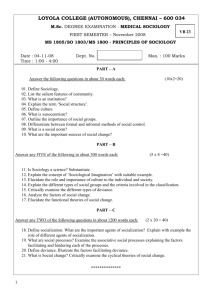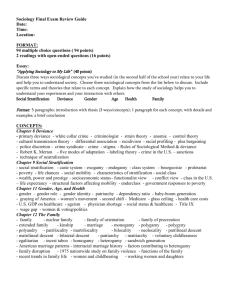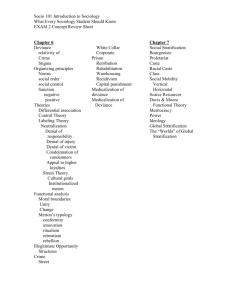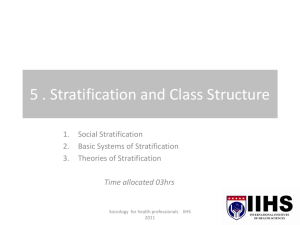sociology final exam study guide
advertisement
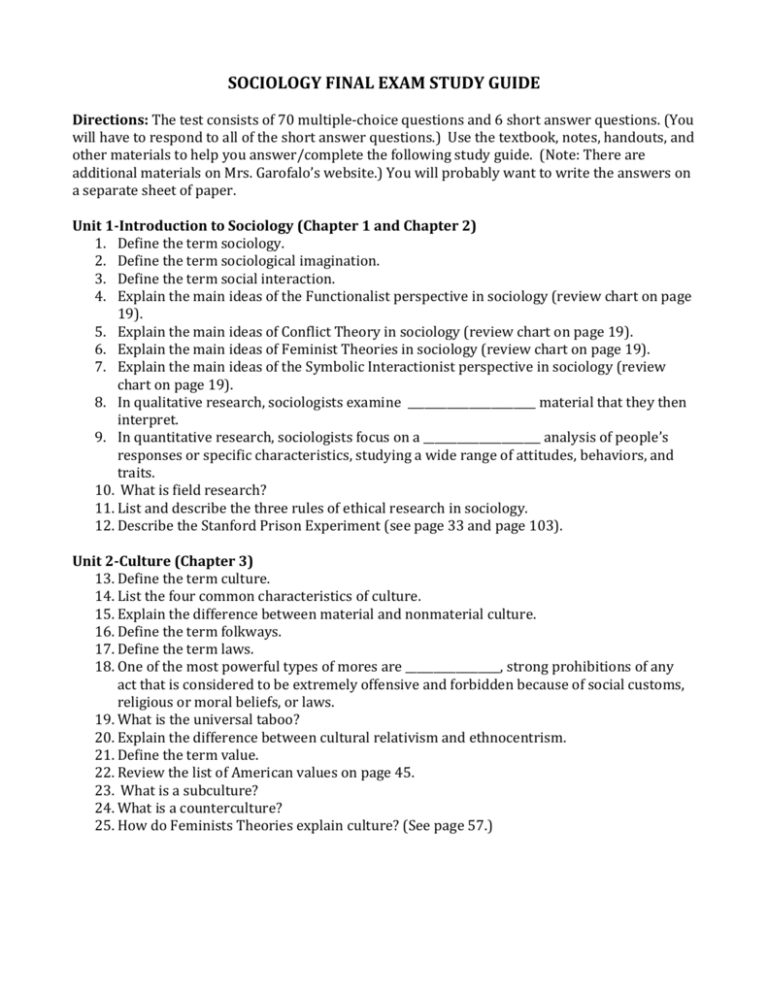
SOCIOLOGY FINAL EXAM STUDY GUIDE Directions: The test consists of 70 multiple-choice questions and 6 short answer questions. (You will have to respond to all of the short answer questions.) Use the textbook, notes, handouts, and other materials to help you answer/complete the following study guide. (Note: There are additional materials on Mrs. Garofalo’s website.) You will probably want to write the answers on a separate sheet of paper. Unit 1-Introduction to Sociology (Chapter 1 and Chapter 2) 1. Define the term sociology. 2. Define the term sociological imagination. 3. Define the term social interaction. 4. Explain the main ideas of the Functionalist perspective in sociology (review chart on page 19). 5. Explain the main ideas of Conflict Theory in sociology (review chart on page 19). 6. Explain the main ideas of Feminist Theories in sociology (review chart on page 19). 7. Explain the main ideas of the Symbolic Interactionist perspective in sociology (review chart on page 19). 8. In qualitative research, sociologists examine _______________________ material that they then interpret. 9. In quantitative research, sociologists focus on a _____________________ analysis of people’s responses or specific characteristics, studying a wide range of attitudes, behaviors, and traits. 10. What is field research? 11. List and describe the three rules of ethical research in sociology. 12. Describe the Stanford Prison Experiment (see page 33 and page 103). Unit 2-Culture (Chapter 3) 13. Define the term culture. 14. List the four common characteristics of culture. 15. Explain the difference between material and nonmaterial culture. 16. Define the term folkways. 17. Define the term laws. 18. One of the most powerful types of mores are _________________, strong prohibitions of any act that is considered to be extremely offensive and forbidden because of social customs, religious or moral beliefs, or laws. 19. What is the universal taboo? 20. Explain the difference between cultural relativism and ethnocentrism. 21. Define the term value. 22. Review the list of American values on page 45. 23. What is a subculture? 24. What is a counterculture? 25. How do Feminists Theories explain culture? (See page 57.) Unit 3-Socialization (Chapter 4) 26. What is the purpose of socialization? 27. The process of socialization begins at ___________________. 28. Sociologists focus on the role of _____________________ in human development. 29. Define the term resocialization. 30. A _________________________ is a place where people are isolated from the rest of society, stripped of their former identities, and required to conform to new rules and behavior. 31. How do jails and detention centers resocialize people? 32. How do Symbolic Interaction Theories explain socialization? (See page 67.) Unit 4-Social Structure (Chapter 5 and Chapter 6) 33. Explain the difference between ascribed status and achieved status. 34. Define the term master status. 35. Explain the concept of an in-group. 36. Explain the concept of an out-group. 37. Describe the problems that having in-groups and out-groups can cause in society. 38. Explain the research and findings of the following sociologists: Asch, Milgram, ZImbardo, and Janis. Unit 5- Deviance, Crime, and the Criminal Justice System (Chapter 7) 39. Define the term deviance. 40. Define the term crime. 41. A stigma is… 42. Explain the job of a criminologist. 43. Durkheim introduced the term ________________ to describe the condition in which people are unsure of how to behave because of absent, conflicting, or confusing social norms. 44. What is organized crime? 45. Corporate crime is… 46. Positive sanctions are rewards for ______________ behavior. 47. Negative sanctions are punishments that convey ________________ for violating a norm. 48. Which country has the highest incarceration rate in the entire world? 49. How do Conflict Theories explain deviance and crime? (See page 123.) 50. How do Feminist Theories explain deviance and crime? (See page 123.) 51. Explain Merton’s Strain Theory. Unit 6- Social Stratification (Chapter 8) 52. What is meant by the expression “the feminization of poverty”? 53. A person’s socioeconomic status is… 54. List the three dimensions of stratification. 55. Identify the three main classes in American society. What types of people belong in each class? 56. What are the common characteristics of the poor? 57. Why are people poor? 58. Why can it be difficult for people to break out of the culture of poverty? 59. How do Functionalists view social stratification? (See page 152.) 60. How do Symbolic Interactionists view social stratification? (See page 152.) 61. How do Conflict Theorists view social stratification? (See page 152.) Unit 7-Social Inequality (Pages 157-164, Chapter 10, and Pages 237-241) 62. Define the term gender roles. 63. Define the term gender stereotypes. 64. List some common gender roles. 65. List come common gender stereotypes. 66. How are gender roles and gender stereotypes hurtful to both men and women? 67. Explain the difference between sex and gender. 68. Define the term sexism. 69. Race refers to people who share physical _________________ such as skin color and facial features that are passed on through reproduction. 70. What is racism? 71. The unfair treatment of a minority group by a dominant group is known as ________________. 72. What is prejudice? 73. Define the term ageism. 74. What is elder abuse? 75. Who is most likely to be the abuser in cases of elderly abuse? 76. Functionalists believe that _______________ people in a given society are treated according to the role the aged play in that society. Unit 8-Social Change and Collective Behavior (Chapter 16) 77. Collective behavior is… 78. The two important characteristics of collective behavior are… 79. What is a rumor? 80. What is gossip? 81. What is an urban legend? 82. What is panic? 83. What is fashion? 84. A casual crowd is… 85. A conventional crowd is… 86. A protest crowd is… 87. A _____________________ is a large and organized activity to promote or resist a particular social change. 88. An alternative movement attempts to change some people in a ___________ way. 89. A _________________ movement attempts to change some people but completely. 90. List the stages of social movements. 91. One of the major factors of social change is _________________. 92. What are some negatives of technology? Unit 9- Population, Urbanization, and the Environment (Chapter 15) 93. Demography is… 94. Population is… 95. List the three factors that cause population change. 96. Malthusian theory claims that the population is… 97. A country experiences zero population growth when… 98. A megacity is a metropolitan area with at least _______ million inhabitants. 99. Urbanization is population movement from ____________ to ____________ areas. 100.Some current environmental issues are…
